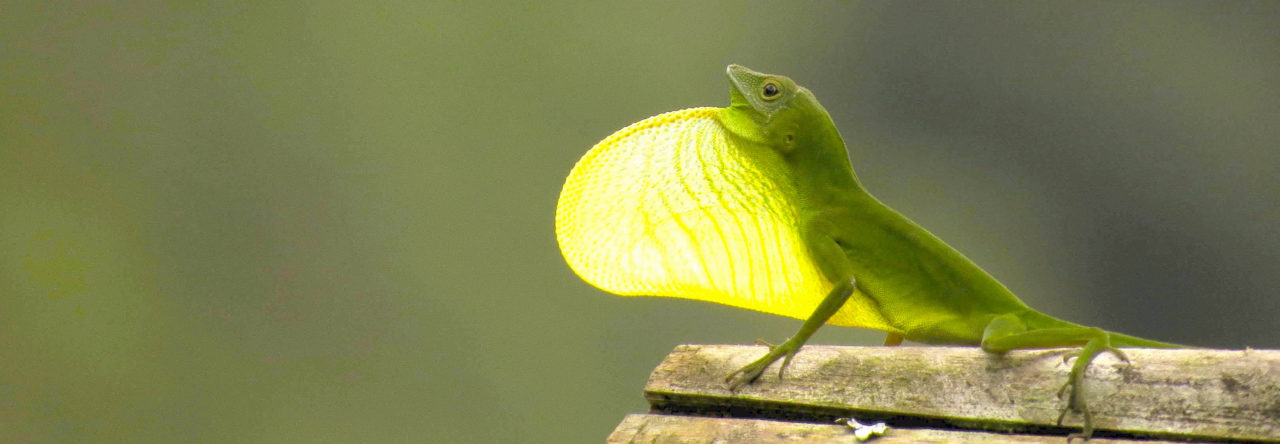
Polychrus gutturosus flashing its stuff. Photo from http://www.bijagual.org/images_reptiles/reptiles_image_links/pages/polychrus_guttorosus_3_JPG.htm
One interesting implication of the recent finding that Anolis and Polychrus are not closely related concerns the evolution of the dewlap. The two genera were long thought to be close relatives in part because they both possess what appear to be similar dewlaps. The new phylogeny indicates that these structures are not indicative of common ancestry, but rather that the two clades have convergently evolved very similar structures.
Dewlap-like structures have, in fact, evolved repeatedly in iguanian lizards (the clade that contains iguanids [in the old, broad sense], agamids, and chameleons). Some of these dewlaps are different from that of anoles—such as the flap of iguanas and the triangular dewlap of Draco—but the dewlaps of the agamid genera Sitana and Otocryptis are dead ringers for those of anoles. In fact, one might argue that Sitana out-anoles anoles with its regal fan pictured below.
The anole dewlap is a complicated structure formed by the elongation of the second ceratobranchial bone and modification of other bones in the throat (see figure below from Lizards in an Evolutionary Tree). Other iguanian dewlaps seem to be based on similar modifications. Surprisingly, however, the anatomy of the dewlap of other lizards has been little studied in most iguanine species; this would make a fascinating study, determinging the extent to which a convergent structure–the dewlap–is built in the same way in different clades. In fact, more generally, we don’t even havea good idea of how many times dewlaps have evolved; a survey across agamids would be particularly interesting–I bet the dewlap has evolved minimally five times in agamids, but who knows?
One last question: why is it that dewlaps have evolved numerous times in the 1200 or so iguanian lizards, and not at all in any of the other 6-7000 squamates?
- Evolution in Real Time on Lizard Island - March 23, 2025
- Spider Snags Adult Anolis osa - March 22, 2025
- An Homage to the Green Anoles of New Orleans - March 21, 2025




Anthony Herrel
Just my five cents but iguanians (s.l.) are among the most visual and least chemically oriented lizards so the fact that dewlaps evolved there and not so much in other clades doesn’t surprise me that much. Add to that the arboreal nature of the critters which makes chemical interactions even more difficult and you have a recipe for success.
Tony Gamble
It’s also possible that iguanian modifications to the hyoid related to lingual prey prehension were a necessary precursor to development of a dewlap and all the other cool gular modifications seen in the clade (e.g. Pogona and Chamaeleonidae).
raj dhage wai
sitana ponticeriana
Rich Glor
Very cool image. Where did you take it? It seems like a very precarious position. Is this guy scouting a territory or just trying to thermoregulate?
Eric Richards
I LOVE these little backyard lizards! There fun to see and play with all the time- and there everywhere here in Florida!